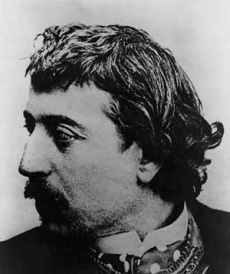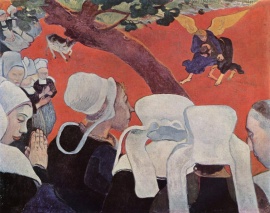Paul Gauguin
UNDER CONSTRUCTION
UNDER CONSTRUCTION
Paul Gauguin was a French post-impressionist painter best known for his paintings of Tahiti. He was heavily interested by Theosophy, Rosicrucianism, spiritualism, and other spiritual movements of the time.
Personal life
Early years
Eugène Henri Paul Gauguin was born on June 7, 1848 in Paris. Due to the revolutionary upheavals in Europe at that time, his family moved to Peru to live with Mme. Gauguin's relatives there. After political unrest in Peru, Gauguin's widowed mother moved her children back to Paris. Paul was sent to live with an uncle in Orléans, and had his early schooling there. When Paul was fourteen, he attended a naval preparatory school in Paris. He served in the French merchant marine and navy for several years, traveling as far as India. Back in France in 1871, Gauguin took a job as a stockbroker at the Paris Bourse and was a successful businessman for eleven years. In addition to stocks, Gauguin dealt in the art market. He married Mette, a Danish woman, and they had five children. After a financial market collapse in 1882, he decided to turn his hobby of painting into a full-time occupation. By 1891, Gauguin's wife and family rejected him.
Later years and death
Gauguin died suddenly on May 8, 1903.
Artistic career
Gauguin's earliest paintings were Impressionistic, created while he was still a stockbroker in Paris. He associated with Camille Pizarro and Paul Cézanne.
Pont-Aven colony and Synthetism
In 1886 Gauguin spent the summer at Pont-Aven in Brittany, which had long been established as an artists colony. Paul Gauguin lived there for many years there in the 1880s and 1890s as the central figure of the colony, along with Paul Sérusier, Émile Bernard, Charles Laval, Édouard Vuillard, Pierre Bonnard, Maurice Denis, and many others. Gauguin had ventured into Cloisonnism, influenced by folk art and Japanese prints. Émile Bernard had pioneered this style of painting with strong outlines and flat areas of color, and Gauguin adopted it. He and the artists at Pont-Aven evolved toward what came to be called Synthetism, where form and color became more balanced. Their work came to be distinguished by subject matter like that of the Belgian Symbolists; lack of interest in realistic representation; and bold use of colors. Their intention was to combine images in new ways that were completely unlike Impressionism.
Influence on Les Nabis
Gauguin had a strong influence on a group of student artists who gathered at the Académie Julian, particularly in the use of color. Led by Paul Sérusier, they called themselves Les Nabis. Their main principle was that an artist worked in symbols and metaphors expressing his own nature.
Tahiti
The Marquesa
Involvement with Theosophical Society
Gauguin's friend Paul Sérusier introduced many new ideas, such as "Edouard Schuré's Les Grands Initiés', a study of world religions in which Christianity, hinduism and Buddhism were given equal place. it was all part of the latest fad sweeping through French intellectural circles, the obsession with Theosophy..."[1] Various forms of esotericism were being explored in their circle of friends - Rosicrucianism, Freemasonry, spiritualism, and Kabbalah. Sérusier and the Nabis were drawn to the Rosicrucianism of Sâr Péladan and his Order of the Rose+Cross.
Among Gauguin's French neighbors in Punaauia was Jean Souvy, who shared some of his intellectual interests:
The main interest Souvy held for Gauguin lay in his personal studies, he was a Theosophist, part of the spreading network launched by Madame Blavatsky, furnished with publications through the San Francisco branch of the Society. Throughout his retirement Souvy worked on a collection of thought on various philosophical and Theosophist topics which he entitled Cogitations... They reveal a mind running on lines close to Gauguin's, especially the, when his thoughts were once again turning to religious topics...[2]
Resources
The Union Index of Theosophical Periodicals lists 7 articles by or about Paul Gauguin.

